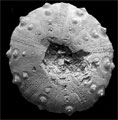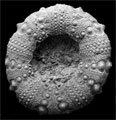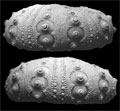The Echinoid Directory
Contributed by Andrew Smith, January 2017
Pseudomilnia Smith, 2016, p. 103
| Diagnostic Features |
|
|---|---|
| Distribution | Middle Jurassic (Aalenian) of England and France. |
| Type | Acrosalenia miliaria Paris, 1908, by original designation. |
| Species Included | No other species included |
| Classification and/or Status | Euechinoidea; Calycina; Salenioida; stem group (acrosaleniid) |
| Remarks | Pseudomilnia resembles Milnia in possessing greatly reduced adapical interambulacral tubercles and in having tiny adradially positioned ambulacral tubercles above the ambitus. In both, the apical disc is strongly elongate, but the apical disc plates in Pseudomilnia were apparently less firmly attached to the corona, as in none of the known specimens is apical disc plating retained. Plates at and above the ambitus are covered in a dense, uniform, fine granulation, forming a wide perradial zone in the ambulacra and broad adradial and interradial bands in the interambulacra. However, whereas Milnia has a sunken peristome with pore-zones remaining uniserial right to the edge of the peristome, Pseudomilnia possesses broad adoral phyllodes that start in the subambital region and incorporate a large number of pore-pairs. This immediately distinguishes the two genera and implies a very different life-style for the two. Recrosalenia is a poorly known taxon from the Bathonian-Callovian of Somalia and differs in having uniserial pore-pairs throughout and simple ambulacral plating with an enlarged tubercle on every third element. Smith, A. B. 2016. British Jurassic regular echinoids. Part 2 Calycina. Monographs of the Palaeontographical Society (no. 646), pp. 69-176, pls 42-82. |




